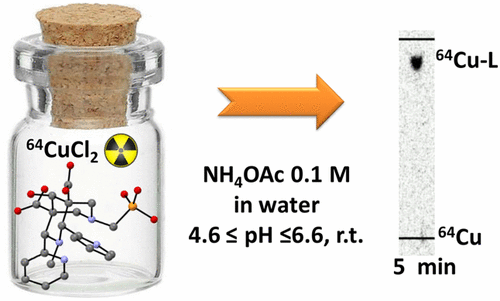当前位置:
X-MOL 学术
›
Inorg. Chem.
›
论文详情
Our official English website, www.x-mol.net, welcomes your feedback! (Note: you will need to create a separate account there.)
A Bispidol Chelator with a Phosphonate Pendant Arm: Synthesis, Cu(II) Complexation, and 64Cu Labeling
Inorganic Chemistry ( IF 4.6 ) Pub Date : 2017-09-15 00:00:00 , DOI: 10.1021/acs.inorgchem.7b01731 Raphaël Gillet 1 , Amandine Roux 1 , Jérémy Brandel 2 , Sandrine Huclier-Markai 3, 4 , Franck Camerel 5 , Olivier Jeannin 5 , Aline M. Nonat 1 , Loïc J. Charbonnière 1
Inorganic Chemistry ( IF 4.6 ) Pub Date : 2017-09-15 00:00:00 , DOI: 10.1021/acs.inorgchem.7b01731 Raphaël Gillet 1 , Amandine Roux 1 , Jérémy Brandel 2 , Sandrine Huclier-Markai 3, 4 , Franck Camerel 5 , Olivier Jeannin 5 , Aline M. Nonat 1 , Loïc J. Charbonnière 1
Affiliation

|
Here we present the synthesis and characterization of a new bispidine (3,7-diazabicyclo[3.3.1]nonane) ligand with N-methanephosphonate substituents (L2). Its physicochemical properties in water, as well as those of the corresponding Cu(II) and Zn(II) complexes, have been evaluated by using UV–visible absorption spectroscopy, potentiometry, 1H and 31P NMR, and cyclic voltammetry. Radiolabeling experiments with 64CuII have been carried out, showing excellent radiolabeling properties. Quantitative complexation was achieved within 60 min under stoichiometric conditions, at room temperature and in the nanomolar concentration range. It was also demonstrated that the complexation occurred below pH 2. Properties have been compared to those of the analogue bispidol bearing a N-methanecarboxylate substituent (L1). Although both systems meet the required criteria to be used as new chelator for 64/67Cu in terms of the kinetics of formation, thermodynamic stability, selectivity for Cu(II), and kinetic inertness regarding redox- or acid-assisted decomplexation processes, substitution of the carboxylic acid function by the phosphonic moiety is responsible for a significant increase in the thermodynamic stability of the Cu(II) complex (+2 log units for pCu) and also leads to an increase in the radiochemical yields with 64CuII which is quantitative for L2.
中文翻译:

具有膦酸酯悬挂臂的Bispidol螯合剂:合成,Cu(II)络合和64 Cu标记
在这里,我们介绍了具有N-甲烷膦酸酯取代基(L 2)的新联吡啶(3,7-二氮杂双环[3.3.1]壬烷)配体的合成和表征。通过使用紫外-可见吸收光谱法,电位法,1 H和31 P NMR和循环伏安法评估了其在水中以及相应的Cu(II)和Zn(II)络合物中的理化性质。64 Cu II的放射性标记实验已经进行了研究,显示出优异的放射性标记性质。在化学计量条件下,室温和纳摩尔浓度范围内,在60分钟内即可完成定量络合。还证明了络合发生在pH 2以下。性质已与带有N-甲烷羧酸酯取代基(L 1)的类似的双吡啶进行比较。尽管两个系统都符合用作64/67的新螯合剂的要求标准就形成动力学,热力学稳定性,对Cu(II)的选择性以及有关氧化还原或酸辅助分解过程的动力学惰性而言,Cu的作用是使膦官能团显着增加,从而取代了羧酸官能团。铜(II)配合物(2个对数单位为PCU)和也引线的热力学稳定性,以与增加的放射化学产率64铜II这是定量为大号2。
更新日期:2017-09-15
中文翻译:

具有膦酸酯悬挂臂的Bispidol螯合剂:合成,Cu(II)络合和64 Cu标记
在这里,我们介绍了具有N-甲烷膦酸酯取代基(L 2)的新联吡啶(3,7-二氮杂双环[3.3.1]壬烷)配体的合成和表征。通过使用紫外-可见吸收光谱法,电位法,1 H和31 P NMR和循环伏安法评估了其在水中以及相应的Cu(II)和Zn(II)络合物中的理化性质。64 Cu II的放射性标记实验已经进行了研究,显示出优异的放射性标记性质。在化学计量条件下,室温和纳摩尔浓度范围内,在60分钟内即可完成定量络合。还证明了络合发生在pH 2以下。性质已与带有N-甲烷羧酸酯取代基(L 1)的类似的双吡啶进行比较。尽管两个系统都符合用作64/67的新螯合剂的要求标准就形成动力学,热力学稳定性,对Cu(II)的选择性以及有关氧化还原或酸辅助分解过程的动力学惰性而言,Cu的作用是使膦官能团显着增加,从而取代了羧酸官能团。铜(II)配合物(2个对数单位为PCU)和也引线的热力学稳定性,以与增加的放射化学产率64铜II这是定量为大号2。



























 京公网安备 11010802027423号
京公网安备 11010802027423号